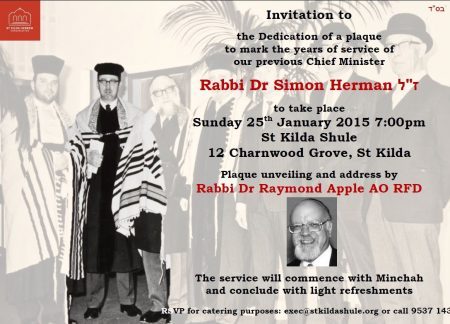Rabbi Dr Simon Herman plaque dedication
Address by Rabbi Dr Raymond Apple at St Kilda Synagogue, Melbourne, on Sunday, 25 January, 2015.

David Havin, Rabbi Yaakov Glasman, Rabbi Apple and Anton Block at the plaque dedication
In 1958 I arrived in the UK to study at Jews’ College. A little later, when St Kilda was in the process of discussions with Dr Simon Herman, he heard of my St Kilda connections. I visited their home and had other conversations with them. I don’t claim that anything I said persuaded them to accept the St Kilda ministry, but my comments might have provided useful background information about the Shule.

At a welcome function in 1959 for Rabbi Dr Simon Herman. Rabbi Herman is seated on the fourth from right.
When they arrived in Melbourne, the Australian Jewish press captioned its report, “Pleasant Dr Herman”. “Pleasant” is the right word to sum up the man’s personality and character.
His St Kilda appointment came at a historic moment. There were high hopes on both sides. But the times were against a successful shidduch. It was an impossible task to come straight after Rabbi Danglow.
Danglow’s style and outlook had moulded St Kilda and the congregation to the extent that, like the 3rd St Kilda scouts, the St Kilda Synagogue was “Danglow’s Own”. No-one, even Moshe Rabbenu, could have taken Danglow’s place or succeeded in his seat and his pulpit. The brevity of Herman’s incumbency was probably no reflection on the man or the congregation, but the result of the times.
Herman brought new energy and ideas to congregational programming, especially in the field of education, supported by his wife as an expert teacher. He knew that strict halachic standards would take time. He attempted gradual acclimatisation to greater orthodoxy, but events erupted like the St Kilda tradition of pre- and post-cremation services for the families of leading congregants.
It was probably made worse when early supporters – apparently including Sir Archie Michaelis – turned against Herman, who now claimed that things in England required his return there, but this was a face-saving statement. Thereafter, Herman held several rabbinic posts in Britain. In time he became a Dayan of the Federation of Synagogues Beth Din, an acknowledgment of his halachic learning.
The Herman chapter is part of the history of the Australian rabbinate. The community, and the rabbinate, were changing. Even amongst the “English” rabbis there were divisions over Zionism, halachah, day schools and a range of other issues. Generally Danglow (backed by St Kilda) had taken a latitudinarian stance, but within a few years the new positions represented by Herman established themselves, even in St Kilda.
Melbourne orthodox congregations were never of one mould, but they all underwent internal change at this period, and St Kilda could not remain aloof from greater orthodoxy. The changes in St Kilda mostly happened after Herman left, but he helped to lay the foundations.
Congregational history has largely forgotten Herman. It is good that his place in the St Kilda tradition should be acknowledged. All credit to today’s leaders who decided on a plaque in his name; all credit to those who have come this evening to see the plaque officially unveiled.
The honour of dedicating the plaque is a precious privilege for me; I now unveil it in tribute to a good and pleasant man who was an ornament to the congregation’s rabbinate.




